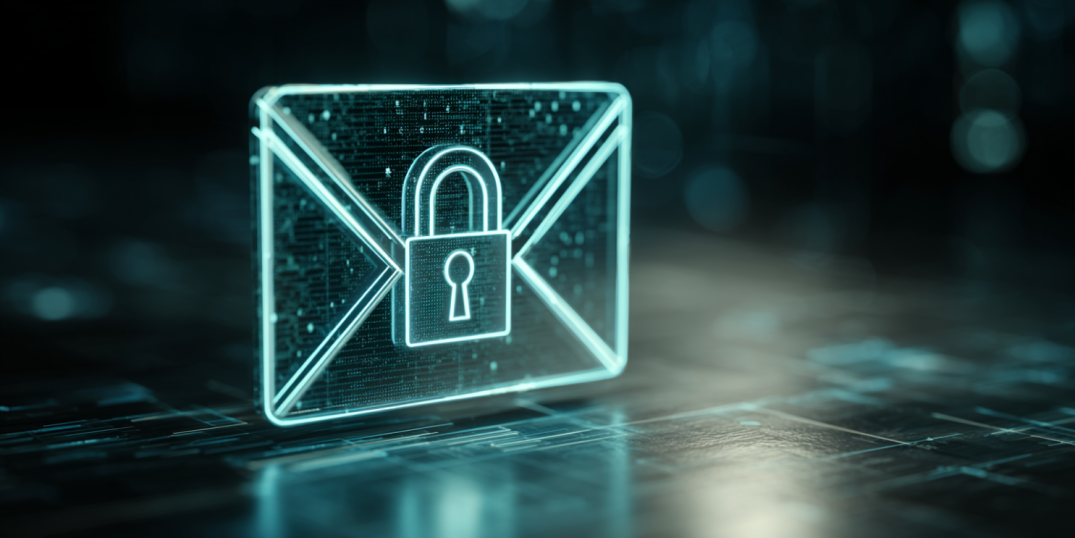- Home
- Fundamentals of Email Marketing
- Email Encryption: What Markete ...

Marketers already have a lot on their plate. They need to think about making catchy subject lines, about the design of their emails, about writing great copy, and about creating actionable CTAs. So, adding email encryption on top of all that might seem like a bit too much, and like this technical detail is better off being outsourced to IT teams. Unfortunately, this assumption no longer holds. As privacy concerns grow and regulations become tighter, marketers must accept the fact that the way they send their emails—and how secure those emails are for users to open—becomes part of the overall user experience.
That’s why in this article we’re going to talk about email encryption not as some abstract sense of security, but as something that can benefit digital marketing in particular. If you’ve ever wondered, “What is email encryption?” or How does email encryption work?” or—even more importantly—“How is it relevant for my email marketing?”—we’ll answer these questions exactly. Since this topic is often buried under jargon and compliance talk, we’ll try to approach it from a different angle: how you, as a marketer, can benefit from encrypting your emails and how it can improve the overall user experience.
What Is Email Encryption?
Email encryption refers to the process of scrambling the contents of an email in such a way that only the intended recipient can read it. This is done using cryptographic algorithms that turn readable data into indecipherable code while the message is in transit. Once it reaches the recipient, the message becomes readable again. It’s a system designed for everyday digital protection in marketing, customer service, and beyond.
So, what is email encryption in more practical terms? Simply put, it makes sure that the content of your email can’t be intercepted, altered, or exposed during delivery. Different email encryption methods offer different levels of protection, so users can pick the one that best matches their needs. Encrypted emails create a closed loop between sender and recipient, reducing risks without requiring the end user to do anything extra—aside from trusting you a little more.
Why Email Encryption Matters in Email Marketing
Marketers usually focus on the effectiveness of subject lines and overall impressions from customer journeys, and email encryption might feel like an IT-level detail far removed from campaign strategy. But that assumption misses a crucial point: privacy and trust have become core components of brand perception. Customers are no longer just evaluating your message—they’re also evaluating how you send it. The reason is both simple and crucial at the same time: data privacy has become more important than ever. Emails, when handled carelessly, can leak personal data or expose confidential content. The result for marketers in this case will undermine hard-won trust. Encryption is the safeguard that prevents that from happening.
To understand why email encryption matters so much, it helps to look beyond the tech itself and focus on what’s at stake. A single unencrypted email might contain a customer’s name, email address, location, and preferences. If intercepted, that information can be used in phishing attempts or sold on. And yet, many businesses still don’t use basic encryption for emails, even when sending sensitive transactional or onboarding content. Considering that email personalization is another must-have, protection of that personal data must become a part of the conversation too.
Another important advantage of proper email encryption is that it contributes to stronger sender reputation and better compliance with privacy laws like the GDPR, HIPAA, and CCPA. While encryption is not a legal requirement in every scenario, failing to implement it—especially if you deal with financial or health-related information—can put companies at legal and reputational risk.
How Encryption Affects Deliverability and Engagement
One of the reasons many marketers still avoid using email encryption in their campaigns is because of a set of persistent myths that have given it an undeservedly negative reputation. Encryption is often seen as an obstacle—something that might get in the way of emails reaching the inbox, or worse, something that could break the flow of a carefully crafted campaign.
So, when marketers believe they have to choose between secure messaging and successful delivery, they tend to drop encryption entirely, treating it as a technical risk rather than a standard safeguard. But this belief doesn’t come from the actual behavior of encryption—it comes from a lack of knowledge about how it works. In the points below, let’s dismantle this myth and take a closer look at how encryption really interacts with deliverability and engagement.
Myths vs. facts: Encryption does not hurt deliverability if implemented correctly
One common concern among marketers is that encrypting emails might affect whether emails land in the inbox. This happens because encryption makes the content unreadable to spam filters, which can trigger suspicion—especially if the message appears to be hiding something or deviates from typical email formatting. But when implemented correctly, email encryption does not harm deliverability. In fact, most email clients and ISPs recognize encrypted messages as secure and legitimate. The key to success is ensuring proper authentication—encrypting content while keeping headers and metadata clean and verifiable.
How DMARC, DKIM, and SPF work with encryption
Authentication protocols like DMARC, DKIM, and SPF work alongside encryption—not against it. These technologies verify that the sender is legitimate and that the message hasn’t been tampered with. When combined with email end-to-end encryption, they form a comprehensive layer of protection that not only secures the message but also helps it reach the inbox.
Impact on open rates and trust indicators (padlocks, verified senders)
Encrypted emails often trigger visual trust cues in the recipient’s inbox—like padlock icons, “secure sender” tags, or verified domain stamps. These small design elements signal credibility and can positively influence open rates. Because when users see that their data is being handled with care, they’re more likely to engage with your brand.
Implementing Email Encryption in Marketing Workflows
Tools to use: Gmail, Outlook, third-party providers (ProtonMail, Zoho, etc.)
For most marketers, enabling email encryption doesn’t require writing code or setting up servers. Gmail and Outlook both support native encryption options, with Gmail offering TLS-based encryption and Outlook enabling S/MIME. For a more privacy-focused approach, platforms like ProtonMail, Tutanota, and Zoho Mail offer email end-to-end encryption by default. These providers handle technical overhead, allowing marketers to focus on content while ensuring that sensitive emails are secured.
Marketing platforms and how they handle security
Popular email marketing platforms such as Mailchimp and HubSpot typically don’t offer full email end-to-end encryption, but they do follow strong encryption standards for data in transit. Additionally, these platforms implement encryption for stored contact data and enforce HTTPS protocols on hosted landing pages. While not all marketing platforms handle encryption the same way, most reputable services integrate encryption for emails at the infrastructure level, which minimizes risks without disrupting your workflow.
What Sensitive Data Are You Protecting with Email Encryption?
✅ Personally identifiable information (PII)
This type of data includes names, addresses, phone numbers, and dates of birth—exactly the kind of details marketers rely on for segmentation and personalization. Every time you are confirming a webinar signup, sending a birthday reward, or managing subscription preferences, this data goes through your emails. Without proper email encryption, such information becomes vulnerable in transit. When you encrypt your emails, you give your users a peace of mind that their most private data are safe with you.
✅ Financial information
Invoices, billing summaries, payment confirmations—all these contain financial data that cybercriminals actively target. If you’re running an e-commerce campaign or handling donor contributions, your messages may include credit card details or banking references. Applying email encryption methods in this case stops being just a recommendation and becomes a necessity. While finding out that your recipient’s DOB or name was compromised can trigger some liability issues, finding out that their account was cleaned because of one unencrypted email is an even bigger concern.
✅ Health or wellness information
Appointment reminders, health program invites, and personalized wellness updates may all fall under protected categories—especially under laws like HIPAA. For healthcare marketers, using email encryption ensures that sensitive wellness content stays private and compliant. Even for non-medical brands offering wellness-related services, securing this data helps avoid reputational damage and preserves user trust.
✅ Login credentials or access links
Emails that include password resets, account verification links, or single-use login tokens must be treated with special care. This is exactly the kind of content hackers look for. Encrypting these messages with email end-to-end encryption is particularly important to preserve your subscribers’ trust and keep your authentication flows safe and well-functioning.
✅ Confidential business information
Marketing teams often send internal documents or client proposals via email. These may contain proprietary information, performance metrics, or contract terms. Even though these aren’t customer-facing messages, they require protection just the same. Using secure channels and applying encryption for emails reduces the risk of leaks and unintended exposure. This is particularly important in distributed teams or agency-client environments.
To Sum Up
As user experience grows and becomes an increasingly comprehensive journey, it also includes safety and protection as a natural part of that experience. This means that email encryption is no longer just a technical decision—it’s also a marketing one.
For marketers who truly want to provide not only efficient and visually compelling campaigns but also safe ones, it’s time to stop seeing email encryption methods as merely a form of compliance. Instead, think of them as a form of respect—for your audience, your data, and the future of your brand. If you’ve ever asked yourself what an encrypted email is, the right answer will be: It’s about showing your subscribers that you care enough to protect what matters, even when it’s invisible.



